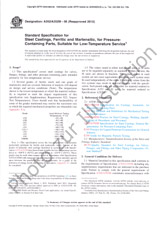Wir benötigen Ihre Einwilligung zur Verwendung der einzelnen Daten, damit Sie unter anderem Informationen zu Ihren Interessen einsehen können. Klicken Sie auf "OK", um Ihre Zustimmung zu erteilen.
ASTM F51/F51M-20
Standard Test Method for Sizing and Counting Particulate Contaminant In and On Clean Room Garments
Name übersetzen
NORM herausgegeben am 1.4.2020
Informationen über die Norm:
Bezeichnung normen: ASTM F51/F51M-20
Ausgabedatum normen: 1.4.2020
SKU: NS-991938
Zahl der Seiten: 8
Gewicht ca.: 24 g (0.05 Pfund)
Land: Amerikanische technische Norm
Kategorie: Technische Normen ASTM
Kategorie - ähnliche Normen:
Die Annotation des Normtextes ASTM F51/F51M-20 :
Keywords:
clean room, fabric, particulate contaminant,, ICS Number Code 61.020 (Clothes)
Ergänzende Informationen
| Significance and Use | ||||||
|
5.1 The test method for particulate sizing and numbers on garments is nondestructive and may be used to evaluate the contamination levels of fibers and particles on and in clean room garments. The test may be used for evaluating the cleanliness levels of new or newly cleaned garments. It also may be used to evaluate the extent of fiber and particulate contamination on garments that have been worn, if necessary. For this application, it is necessary to sample representative areas of the garment fabric. |
||||||
| 1. Scope | ||||||
|
1.1 This test method covers the determination of detachable particulate contaminant 5 μm or larger, in and on the fabric of clean room garments. 1.2 This test method does not apply to nonporous fabrics such as Tyvek (trademarked) or Gortex (trademarked). It only applies to fabrics that are porous such as cotton or polyester. 1.3 This test method provides not only the traditional optical microscopic analysis but also a size distribution and surface obscuration analysis for particles on a fine-textured membrane filter or in a tape lift sample. It utilizes transmitted illumination to render all particles darker than the background for gray level detection. Particles collected on opaque plates must be transferred to a suitable membrane filter. 1.4 Units—The values stated in either SI units or inch-pound units are to be regarded separately as standard. The values stated in each system are not necessarily exact equivalents; therefore, to ensure conformance with the standard, each system shall be used independently of the other, and values from the two systems shall not be combined. 1.5 This standard may involve hazardous materials, operations, and equipment. This standard does not purport to address all of the safety concerns, if any, associated with its use. It is the responsibility of the user of this standard to establish appropriate safety, health, and environmental practices and determine the applicability of regulatory limitations prior to use. 1.6 This international standard was developed in accordance with internationally recognized principles on standardization established in the Decision on Principles for the Development of International Standards, Guides and Recommendations issued by the World Trade Organization Technical Barriers to Trade (TBT) Committee. |
||||||
| 2. Referenced Documents | ||||||
|
Empfehlungen:
Aktualisierung der technischen Normen
Wollen Sie sich sicher sein, dass Sie nur die gültigen technischen Normen verwenden?
Wir bieten Ihnen eine Lösung, die Ihnen eine Monatsübersicht über die Aktualität der von Ihnen angewandten Normen sicher stellt.
Brauchen Sie mehr Informationen? Sehen Sie sich diese Seite an.




 Cookies
Cookies
